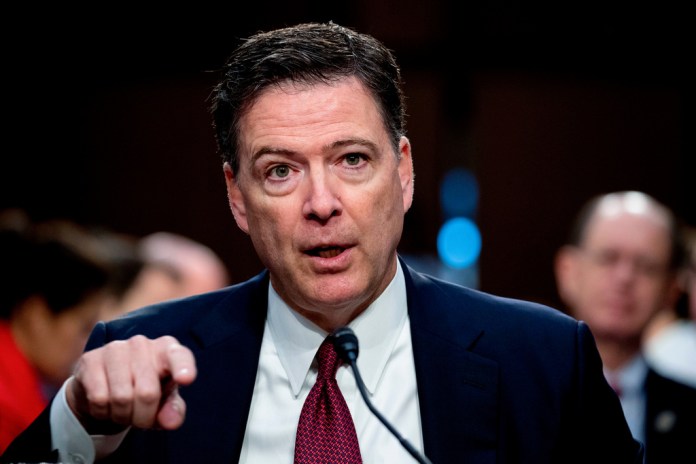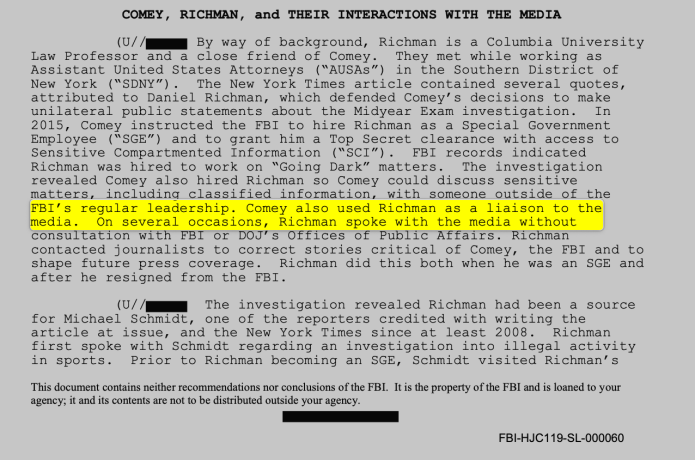A recently unsealed court filing shows prosecutors are drawing directly from a 2017 FBI leak investigation to support criminal charges against former FBI Director James Comey, reinforcing allegations that he misled Congress about authorizing disclosures tied to the Hillary Clinton email case and sensitive intelligence.
The filing, entered Monday by Comey’s legal defense team, confirms that evidence collected in the leak investigation, codenamed Arctic Haze, is central to the Justice Department’s false-statement and obstruction case against him. Those findings could cast doubt on Comey’s sworn 2020 testimony before Congress, in which he maintained his previous claim that he never allowed anyone at the FBI to serve as an anonymous source for news reports about politically charged investigations.

Comey, 64, pleaded not guilty on Oct. 8 to one count of making a false statement to Congress and one count of obstructing a congressional proceeding.
Records say Comey used outside adviser to steer messaging around Clinton inquiry
Internal FBI investigative memos declassified and released by Sen. Chuck Grassley (R-IA) state that Comey personally directed Columbia Law School professor Daniel Richman to be designated a Special Government Employee with access to classified information. Those records assert that Comey placed Richman in that role so he could discuss sensitive matters “with someone outside of the FBI’s regular leadership” and so Richman could act as a “liaison to the media” when press narratives broke against the bureau.

Investigators focused on an April 22, 2017, New York Times article about Comey’s unilateral decision to announce the outcome of the Clinton case. That reporting referenced sensitive intelligence concerning then–Attorney General Loretta Lynch: a purported email, taken by U.S. intelligence from Russian servers, that claimed Lynch had assured the Clinton campaign she would not allow the FBI investigation into Clinton to proceed too far. FBI records cited by Congress say the email was assessed to have been fabricated by Russian operatives. Yet, Comey nevertheless directed Richman to reference it in conversations with the press to defend his public announcement about the closing of the Clinton inquiry.
Richman’s established history of communicating with reporters about Comey and the FBI is also key to the government’s allegation that Comey’s later denials to Congress were misleading. The defense’s filing notes that Richman was also Comey’s attorney at one point.
The charging documents refer to individuals by number rather than by name, identifying a “Person 1” who is likely former Secretary of State Hillary Clinton. The individual prosecutors allege Comey authorized to communicate with the media is listed as “Person 3,” which a source familiar with the indictment previously told CNN is Richman, and which appears to be corroborated by the defense’s filing.
Filter-protocol dispute could determine what evidence reaches the jury
Comey’s Monday filing was submitted to oppose a motion prosecutors filed on Oct. 13 seeking court authorization for a filter protocol, a process in which a separate Justice Department review team would screen seized digital materials for potentially privileged attorney-client communications before the trial team receives access.
The defense motion states that the government has represented that a prior filter team in Washington screened seized materials from 2020 warrants for privilege during the Arctic Haze leak investigation in coordination with Richman’s counsel, but that Comey and his attorneys at the time were not included in that process. It says prosecutors have not established what was reviewed, what was withheld, or how privileged communications involving Comey’s lawyers were handled.
In their Oct. 13 motion, prosecutors asked the court to authorize a new, court-supervised filter review of any quarantined evidence before the prosecution team sees it. They pointed to concerns flagged years earlier by the Justice Department’s Office of Inspector General in an August 2019 report, which concluded Comey mishandled sensitive FBI memoranda and set “a dangerous example” for employees.
That same report also noted that Comey leaked copies of personal memos that documented conversations he had with then-President Donald Trump to three attorneys, including Richman, David Kelley, and Comey’s current defense counsel, Patrick Fitzgerald. Last week, prosecutors indicated Fitzgerald’s presence on his defense team raises its own separate “question of conflict and disqualification.”
Comey’s attorneys counter that prosecutors are improperly trying to “revive” years-old warrants from a separate leak matter to support new criminal charges, arguing such a move would be unlawful.
U.S. District Judge Michael Nachmanoff, an appointee of former President Joe Biden, will decide whether the government may proceed in the coming weeks.
False-statement allegation centers on 2020 exchange with Cruz
The indictment focuses on Comey’s testimony before the Senate Judiciary Committee on Sept. 30, 2020. During that hearing, Sen. Ted Cruz (R-TX) revisited Comey’s prior denials about authorizing leaks of investigative information. Cruz quoted Comey’s May 2017 testimony before the same committee, where Comey had stated that he had “never” been an anonymous source and had “never” authorized anyone else to be one either. Cruz noted that former Deputy FBI Director Andrew McCabe had publicly claimed the opposite.
When pressed, Comey told Cruz, “I stand by the testimony you summarized that I gave in May of 2017,” and again stated that his prior testimony was “the same today.” Prosecutors argue this reaffirmation, made for the second time within the statute of limitations, is an actionable false statement.
What comes next
The 2017 leak-investigation material could help establish what Comey authorized behind the scenes and whether that was consistent with what he later told Congress. Defense lawyers argue the government’s effort amounts to a fishing expedition into privileged legal files and would set a troubling precedent for reviewing old investigative material.
Notably, the defense’s motion shows the central dispute in the case is no longer just what Comey told Congress in 2020, but whether investigators can now revisit a years-old leak investigation to test the truthfulness of those statements. And as the court weighs how much evidence jurors will see, Comey’s media strategy during the tumultuous end of the 2016 election season could become a more prominent issue during his upcoming trial, presently slated for the first full week in January.
COMEY HIRED POSSIBLE WITNESS AS HIS LAWYER TO BLOCK TESTIMONY, DOJ SAYS
Meanwhile, Comey’s claims of a vindictive prosecution will be heard before Nachmanoff in Alexandria on Nov. 19.
Comey is also seeking to have U.S. Attorney Lindsey Halligan disqualified from his case. Oral arguments are scheduled for Nov. 13 in South Carolina before U.S. District Judge Cameron Currie, a Clinton appointee. During the same hearing, Currie is expected to weigh a similar effort by New York Attorney General Letitia James, who recently pleaded not guilty to mortgage fraud charges and, like Comey, is seeking to remove Halligan from her case.
